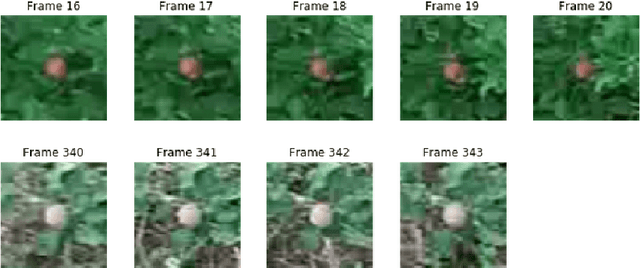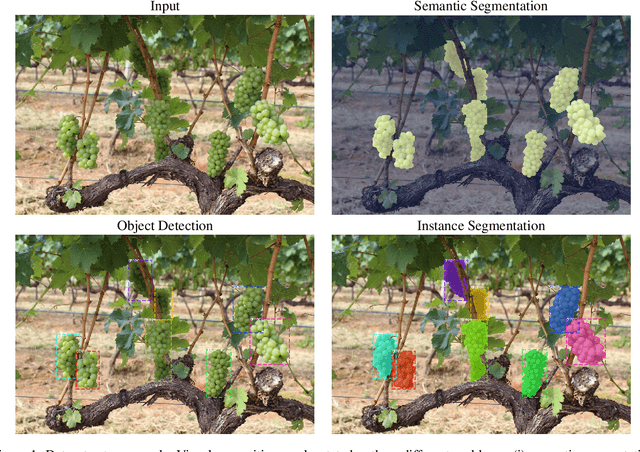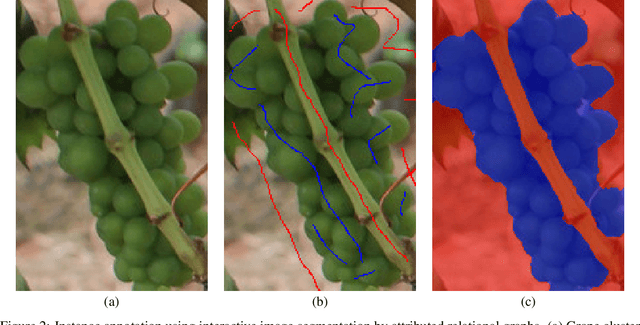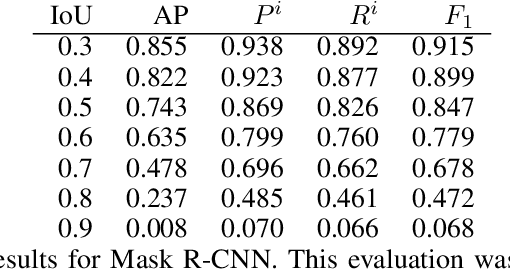Thiago T. Santos
A pipeline for multiple orange detection and tracking with 3-D fruit relocalization and neural-net based yield regression in commercial citrus orchards
Dec 27, 2023Abstract:Traditionally, sweet orange crop forecasting has involved manually counting fruits from numerous trees, which is a labor-intensive process. Automatic systems for fruit counting, based on proximal imaging, computer vision, and machine learning, have been considered a promising alternative or complement to manual counting. These systems require data association components that prevent multiple counting of the same fruit observed in different images. However, there is a lack of work evaluating the accuracy of multiple fruit counting, especially considering (i) occluded and re-entering green fruits on leafy trees, and (ii) counting ground-truth data measured in the crop field. We propose a non-invasive alternative that utilizes fruit counting from videos, implemented as a pipeline. Firstly, we employ CNNs for the detection of visible fruits. Inter-frame association techniques are then applied to track the fruits across frames. To handle occluded and re-appeared fruit, we introduce a relocalization component that employs 3-D estimation of fruit locations. Finally, a neural network regressor is utilized to estimate the total number of fruit, integrating image-based fruit counting with other tree data such as crop variety and tree size. The results demonstrate that the performance of our approach is closely tied to the quality of the field-collected videos. By ensuring that at least 30% of the fruit is accurately detected, tracked, and counted, our yield regressor achieves an impressive coefficient of determination of 0.85. To the best of our knowledge, this study represents one of the few endeavors in fruit estimation that incorporates manual fruit counting as a reference point for evaluation. We also introduce annotated datasets for multiple orange tracking (MOrangeT) and detection (OranDet), publicly available to foster the development of novel methods for image-based fruit counting.
A methodology for detection and localization of fruits in apples orchards from aerial images
Oct 24, 2021



Abstract:Computer vision methods based on convolutional neural networks (CNNs) have presented promising results on image-based fruit detection at ground-level for different crops. However, the integration of the detections found in different images, allowing accurate fruit counting and yield prediction, have received less attention. This work presents a methodology for automated fruit counting employing aerial-images. It includes algorithms based on multiple view geometry to perform fruits tracking, not just avoiding double counting but also locating the fruits in the 3-D space. Preliminary assessments show correlations above 0.8 between fruit counting and true yield for apples. The annotated dataset employed on CNN training is publicly available.
Grape detection, segmentation and tracking using deep neural networks and three-dimensional association
Aug 12, 2019



Abstract:Agricultural applications as yield prediction, precision agriculture and automated harvesting need systems able to infer the culture state from low cost sensing devices. Proximal sensing using affordable cameras combined to computer vision have seen a promising alternative, strengthened after the advent of convolutional neural networks (CNNs) as an alternative for challenging pattern recognition problems in natural images. Considering fruit growing monitoring and automation, a fundamental problem is the detection, segmentation and counting of individual fruits in orchards. Here we show that for grape wines, a crop presenting large variability in shape, color, size and compactness, grape clusters can be successfully detected, segmented and tracked using state-of-the-art CNNs. In a dataset containing 408 grape clusters from images taken on field, we have reached a F1-score up to 0.91 for instance segmentation, a fine separation of each cluster from other structures in the image that allows a more accurate assessment of fruit size and shape. We have also shown as clusters can be identified and tracked along video sequences recording orchards rows. We also present a public dataset containing grape clusters properly annotated in 300 images and a novel annotation methodology for segmentation of complex objects in natural images. The presented pipeline for annotation, training, evaluation and tracking of agricultural patterns in images can be replicated for different crops and production systems. It can be employed on the development of sensing components for several agricultural and environmental applications.
 Add to Chrome
Add to Chrome Add to Firefox
Add to Firefox Add to Edge
Add to Edge